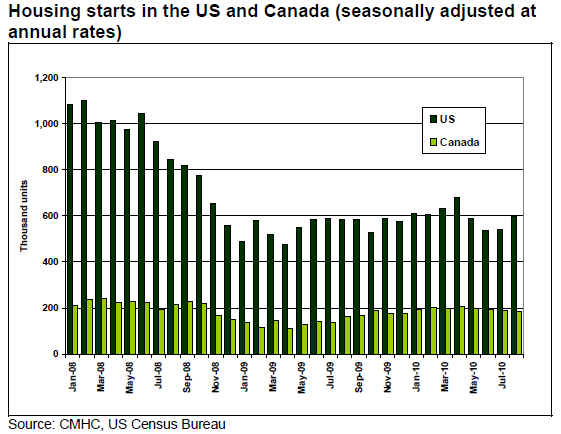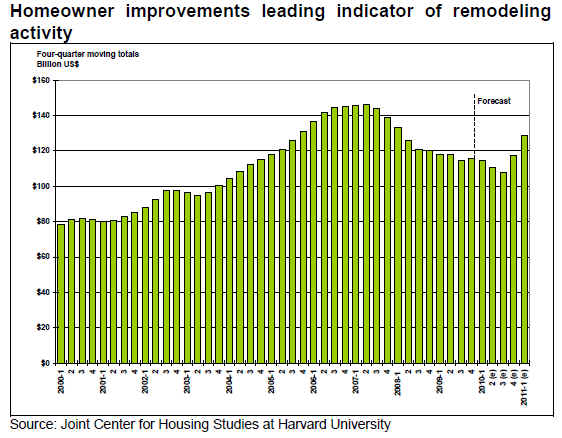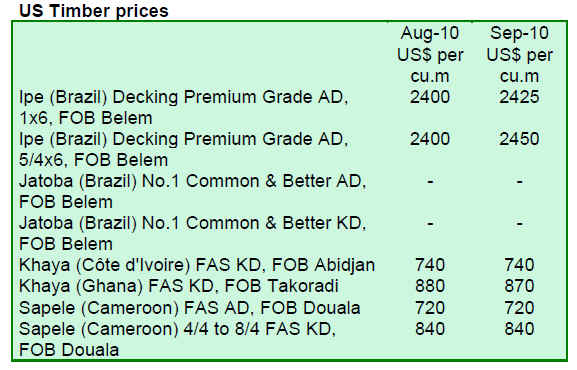|
Report
from
North America
US housing starts rose in August
Sales of new homes continue to be hampered by the large number of foreclosed homes for sale in the US and uncertainty about the economy and the job market. Builders¡¯ confidence in the market for newly built, single-family homes remains low, according to the September National Association of Home Builders/Wells Fargo Housing Market Index.
US housing starts increased in August to 598,000 (seasonally adjusted rate). This is a 10.5% increase from the previous month and +2.2% above the August 2009 rate. Multi-family housing starts grew more than single-family starts. The number of building permits authorized in August increased slightly from July (+1.8%), but this is still 6.7% below August 2009 figures. Permits for single-family homes decreased by 1.2% from July. The number of permits issued can be an indicator of future building activity.

Positive outlook for home renovation
The outlook is more positive on the home renovation side. Homeowner improvement spending in the US is expected to grow by almost 5% in 2010. The Leading Indicator of Remodeling Activity by the Joint Center for Housing Studies at Harvard University expects spending on remodeling will recover this year.

US housing market to remain depressed despite low mortgage rates
The US housing market could remain depressed for several years to come, according to the International Monetary Fund (IMF) World Economic Outlook report released in early October. If the economy does not recover, the risk of another decline in the US real estate market increases. Morgan Stanley predicts that home prices in the US will fall even further in 2011 and possibly 2012, followed by four years of low prices.
This is despite very low mortgage rates. The average rate for 30-year fixed loans dropped to 4.27%, according to an announcement by mortgage buyer Freddie Mac in early October. This is the lowest on records dating back to 1971. The 30-year rate was 5.08% at the beginning of April.
In the second quarter of 2010, foreclosed homes accounted for 24% of total residential sales in the US, according to a report by RealtyTrac. Nevada, Arizona and California are the hardest hit in terms of the share of foreclosure properties. About half of the home sales in these three states were foreclosed properties in the second quarter of 2010. Some eastern states and Florida also have high rates of foreclosures.
Homes that are in foreclosure or bank-owned put pressure on the US housing market. According to estimates by Standard & Poor's, this shadow inventory of homes will take about 40 months to clear. This means that US demand for new housing will remain low for almost three years.
Impact of the US housing market on the woodworking industry
Most wood manufacturing industries depend directly or indirectly on the performance of the housing market. These include manufacturers of flooring, moulding and millwork, decking, cabinets, furniture and decking. A recent survey by Virginia Tech University, the US Forest Service and the trade journal Wood & Wood Products found that 81% of the respondents (woodworking professionals) lost a significant amount of business when the US housing market declined in 2009. The downturn in home renovation and non-residential construction also affected sales. Competition from other supplier countries or non-wood products was of less concern to the survey respondents.
Although low housing starts reduced demand for wood products, the home renovation/remodelling market fared better. Many manufacturers diversified from supplying mainly new single-family homes to the remodelling market. Others focused on developing new products, improving product quality, lowering prices or reducing costs. However, among the respondents who reported no decrease in sales volumes, few mentioned lowering prices in response to the difficult market situation.
Other trends found by the survey include an increase in demand for products that comply with green building standards, and custom and semi-custom products.
New promotion programme for softwood sawnwood
Producers of softwood sawnwood have probably been hardest hit by the downturn in the US housing market. The US Department of Agriculture officially announced a softwood sawnwood promotion programme on 1 October, 2010, and it is asking for comments on the planned programme that would promote the use of softwood sawnwood in the US. The programme is industry-managed and financed. If it goes ahead, softwood sawnwood companies would have to pay US$0.35 per thousand board feet produced or imported into the US, excluding volumes below 15 million board feet. The projected income would be US$12-19 million per year, depending on shipments levels. The programme has been developed by a committee of 21 major softwood sawnwood manufacturers in the US and Canada. In the past, voluntary programmes with similar goals were not effective, and the industry hopes that this mandatory approach will provide sustainable funding for a long-term programme.
Historically, new housing starts accounted for about 40% of total softwood sawnwood consumption in the US. In 2009, this share dropped to under 20%, and total softwood sawnwood consumption halved between 2005 and 2009. The promotion programme¡¯s goal includes increasing the use of wood in non-residential construction, multi-family construction and regaining market share in outdoor living products (decking, outdoor furniture, etc.). The programme would develop consumer and industry information and advertising designed to build markets for softwood sawnwood, enhance the image and reputation of softwood sawnwood and the forests from which it comes, and develop new applications for softwood sawnwood. The promotion is generic and not origin-specific, i.e. it is for softwoods in general, whether they are from Canada, the US or other countries.
The promotion programme has the potential to affect markets for tropical wood products, especially in decking and other outdoor products. However, in most applications tropical species do not compete directly with softwood, especially with structural softwood sawnwood which represents the majority of production in the US and Canada. In outdoor living products, the target of the programme would be wood-plastic composites that are taking an ever-growing share in decking, fencing and similar outdoor products. Given that tropical sawnwood is also substituted with wood-plastic composites, the softwood promotion programme may even have a positive effect for tropical sawnwood producers, depending on how the promotional messages are worded and delivered.

Related News:
|